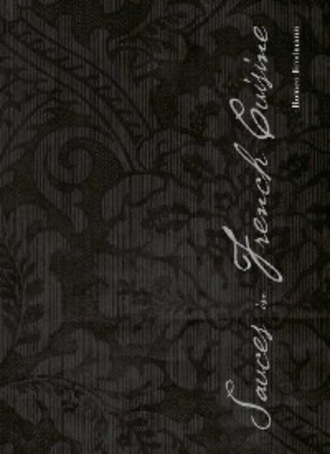
Полная версия
Sauces in French Cuisine
1859 | Started his apprenticeship at the age of 13 in the kitchen, table service and buying of produce in the restaurant belonging to his uncle. Then first jobs as a chef at the Hotel Belleveue near Nice and in the Petit Moulin Rouge in Paris.
1866 | Chef de cuisine in the French general staff, among others during the Franco-Prussian War (1870 to 1871). Prisoner of war.
1872 | Return to Nice as the chef de cuisine at the Hotel Luxemburg.
1873 | Then to Paris, as the chef de cuisine at the Petit Moulin Rouge.
1876 | Opening of his own restaurant Le Faisan doré in Cannes.
1878 | On 28 August marriage to Delphine Daffis, with whom he had three children Paul, Daniel and Germaine.
1879 | Took over the management of the Maison Chevet at the royal palace in Paris.
1880 | Chef de cuisine in the Casino in Boulogne-sur-Mer and in the Restaurant Maire in Paris.
1884 | César Ritz recruits Auguste Escoffier as chef de cuisine. First attempts to rethink traditional French cuisine.
1890 | Took over the management of the kitchen at the Savoy Hotel in London, where important creations such as the Homard à l’américaine, Poire Hélène or Pêche Melba were developed.
1897 | Disputes with the owners of the Savoy. Escoffier leaves the Savoy with the majority of his team and returns to Paris where he was recruited by César Ritz for the reopening of the Ritz on the Place Vendôme for the organisation of the kitchen. The European gourmet community already follows him everywhere.
1899 | Reorganisation and management of other kitchens on behalf of César Ritz, among others that of the Ritz in London. The arrangement to manage the kitchens of the hotels in London and Paris for César Ritz lasted until 1920. Escoffier works on his culinary guide, the «Guide Culinaire».
1903 | His work Guide Culinaire, a culinary guide, is published.
1919 | Escoffier is appointed an Knight of the Legion of Honour by the French President Raymond Poincaré. In the same year, Escoffier, who is now 73, writes his memoirs «L’aid-mémoire culinaire». The first edition appears in 1923.
1920 | Escoffier retires with his wife.
Guide Culinaire
The content of the culinary guide, or to give it its original title in French «Guide Culinaire», still appears very simple, streamlined, extremely contemporary and above all timeless, even today. Even more than a hundred years after the first edition, the content and language of every teaching manual of the present is based on Escoffier’s culinary guide. Even if the basics already existed back then, the culinary foundations were still an unordered pluralism of styles at the end of the 19th century. Ordering structures were not defined; there was an extensive lack of clarity and ease of understanding. As the initiator of the Grand Cuisine and as the créateur of diverse dishes still used today, Auguste Escoffier left an indelible mark on French cuisine, even though he did not of course invent the cuisine. Work techniques, production practices, types of basic preparation and the most important dishes and creations already existed. The ingenuity of his work lay in the way he merged, straightened, streamlined and structured the existing processes and brought a new, heavily simplified and easy-to-understand order to them. Escoffier was not only a brilliant chef, he was also very obviously an outstanding organiser with exceptional management qualities. He not only reorganised the traditional cuisine with all its national and international styles and influences; he also restructured kitchen organisation with all its work processes into the form that we know today, with its brigade system and allocation of duties at specific locations. It was probably hardly an accident that Escoffier’s work was done at precisely the time of developing classic modernism. At the beginning of the 20th century, a variety of new artistic styles starts to develop that, although they are based on the past, nevertheless revolutionise the present. Cubism, constructivism, Dadaism and surrealism develop. Expressionism, the new objectivity and Bauhaus develop. And behind all of it the striving to comprehend the reality behind things. Escoffier’s work is basically the fundamental disclosure of the logical structure of French cuisine. Its simplicity was and is so ingenious that the Guide Culinaire constitutes both the formal and the practical basis for the Western world’s cuisine because it describes the fundamental reality that underlines a chef’s art.

Bouillon de Viande / Bouillon a l’Os (Meat Broth / Bone Broth)
Ingredients for 1 l (1 3/4 pt or 4 1/2 U.S. cups)
800 g (1 lb 12 oz) beef brisket bones, roughly chopped
1.5 l (2 5/8 pt or 6 1/2 U.S. cups) water
500 g (1 lb 2 oz) vegetables: equal amounts of carrots, celeriac, leek, white turnips
1 pc/s onion
spices: salt, 1 bay leaf, 1 clove, 5 peppercorns
Preparation
Boil beef briskets (blanch): place in boiling water (1:10), let boil for 2 minutes, drain, rinse bones first with hot, then with cold water.
Cut vegetables into thumb size pieces. Halve the onion (for colour), place in hot pan, cut side down and blacken. Set aside.
Place beef brisket in pot, cover with 1.5 l (2 5/8 pt or 6 1/2 U.S. cups) of cold water, add salt, slowly bring to the boil, skim frequently.
Reduce heat, gently boil for 1 hour, then add spices, vegetables and blackened onions and continue to softly boil for another 30 minutes to 1 hour.
Drain through a coarse sieve, then through a very fine tea strainer. Season to taste with salt and pepper.
Note
Blackened onions can be replaced by caramel couleur: put 50 g (2 oz) of sugar in a small pan, heat and blacken, then deglaze with 100 ml (3 1/2 fl oz or 1/2 U.S. cups) of water, let dissolve and cool. Only add amount required to obtain desired colour to broth.
Bones can be replaced in part or in total by boiled beef, thus turning bone broth into meat broth. The more meat is used, the stronger the broth.
Add water during the boiling process if necessary (evaporation).
Bouillon de Viande / Bouillon à l’Os
A carefully prepared Bouillon de Viande will serve as an excellent basis for different stocks, sauces and dishes due to its strength. Please make sure never to cover a Bouillon de Viande. It will otherwise become cloudy.
1. Prepare, wash vegetables and cut into thumb size cubes.
2. Cut unpeeled onion in half.
3. Place onions in hot frying pan, without adding any oil.
4. Roast onions until they have blackened.
5. Add bones to water at full rolling boil.
6. Add meat, briefly bring water to the boil and drain off.
7. Rinse bones and meat, first with hot, then with cold water, then place in pot with cold water.
8. Bring to the boil and gently boil for 1.5 hours. Skim and degrease frequently.
9. Add vegetables and blackened onions after 1.5 hours.
10. Add a little salt to the broth.
11. Add spices. Continue to gently boil for another 30 minutes to 1 hour.
12. At the end, strain the Bouillon de Viande through a cheesecloth.

1. Prepare, wash vegetables and cut into thumb size cubes.

2. Cut unpeeled onion in half.

3. Place onions in hot frying pan, without adding any oil.

4. Roast onions until they have blackened.

5. Add bones to water at full rolling boil.

6. Add meat, briefly bring water to the boil and drain off.
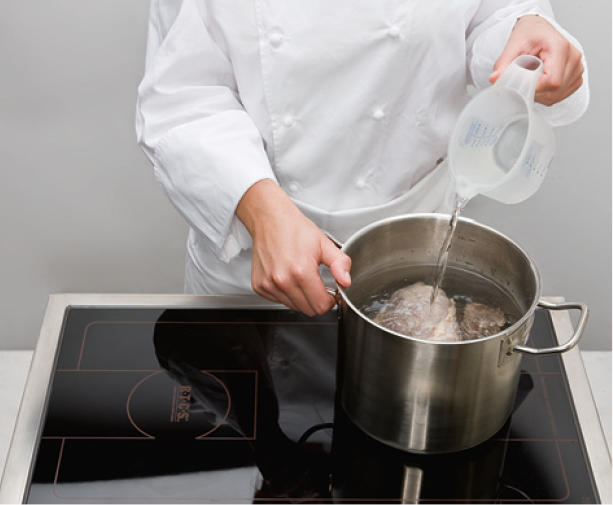
7. Rinse bones and meat, first with hot, then with cold water, then place in pot with cold water.

8. Bring to the boil and gently boil for 1.5 hours. Skim and degrease frequently.

9. Add vegetables and blackened onions after 1.5 hours.

10. Add a little salt to the broth.

11. Add spices. Continue to gently boil for another 30 minutes to 1 hour.

12. At the end, strain the Bouillon de Viande through a cheesecloth.
Fond brun / Estouffade (Brown stock)
Ingredients for 1 l (1 3/4 pt or 4 1/2 U.S. cups)
20 ml (3/4 fl oz or 1/10 U.S. cups) oil (sunflower or peanut oil)
400 g (14 oz) brisket of beef with bones or shin
400 g (14 oz) breast of veal with bones
100 g (3 1/2 oz) bacon rind
100 g (3 1/2 oz) knuckle of ham, blanched
100 g (3 1/2 oz) onions
100 g (3 1/2 oz) carrots
20 g (2/3 oz) parsley stalks, thyme
1.8 l (2 5/6 pt or 6 1/2 U.S. cups) water (consider evaporation during preparation)
spices: salt, garlic, 1 bay leaf, 1 clove, 5 peppercorns
Preparation
Bone out beef brisket and breast of veal. Chop bones into small pieces. Cut the meat from the beef brisket, the breast of veal and the shin into thumb size pieces, set aside. Mix bones with a little oil, roast and lightly brown them in oven for 30 to 45 minutes. At the end, add onions and carrots and let everything roast for another 10 minutes. Place the bones together with the bacon rind and the knuckle of ham in a pot, fill with 1.8 l (2 5/6 pt or 6 1/2 U.S. cups) of cold water, add a little salt, bring to the boil and gently boil for at least 3 hours. The original recipe calls for boiling the bones for 12 hours. Regularly add boiling water to replace the evaporated liquid during the boiling process. Sear and brown the meat cut into pieces on all sides. Then deglaze with 200 ml (7 fl oz or 7/8 U.S. cups) of the prepared stock and reduce to a glaze until everything starts to roast again. Repeat process once or twice and add to stock. Continue to gently boil for a total of another 3 hours. Add thyme, parsley stalks, garlic, bay leaf, clove and peppercorns 1/2 hour before finishing and continue to gently boil. Strain the stock through cheesecloth and reduce to 1 l (1 3/4 pt or 4 1/2 U.S. cups).
Note
May be used as the basis for brown stocks and sauces instead of meat or bone broth, wine or water, according to taste. In particular the beef and the shin as well as the knuckle of ham give the stock a strong, at times a hearty note.
In respect of this stock, Escoffier considered it an error to colour the stock by overly roasting the ingredients because he claimed that the osmazome contained in meat would suffice to reach the required colour. (Osmazome = substance imparting meaty smell and taste to liquid during cooking).
Fond de Veau Brun (Brown Veal Stock)
Ingredients for 1 l (1 3/4 pt or 4 1/2 U.S. cups)
20 ml (3/4 fl oz or 1/10 U.S. cups) oil (sunflower or peanut oil)
600 g (21 oz ) veal bones, chopped into thumb size pieces
200 g (7 oz) calf’s feet, chopped into thumb size pieces
200 g (7 oz) vegetables: carrots, celeriac, onions (no leek, would turn bitter during roasting)
30 g (1 oz) tomato puree
1.5 l (2 5/8 pt or 6 1/2 U.S. cups) water (2 to 3 times > 500 ml (18 fl oz 2 1/4 U.S. cups))
600 ml (1 pt or 2 5/8 U.S. cups) white wine
1l (1 3/4 pt or 4 1/2 U.S. cups) broth or Fond Brun
spices: salt, 1 bay leaf, 1 clove, 5 peppercorns, 1 sprig of thyme
Preparation
Roasting Variant 1: Mix veal bones and calf’s feet with the oil in a frying pan (iron or cast iron pans are best suited, but coated pans also work) and roast slowly and carefully for 1 to 1.5 hours, turn occasionally. Place bones in a bowl. Slowly and gently roast vegetables for approx. 30 minutes in the same pan. Add tomato puree and roast together for 10 minutes.
Roasting Variant 2: Mix veal bones and calf’s feet with the oil, place in (coated or uncoated) metal roasting pan. Place on grid in heated oven (200 °Celsius), medium height, roast for 2 to 3 hours, turn occasionally. Keep an eye on temperature, reduce heat before it starts to burn. Add vegetables, continue to roast for 30 minutes. Add tomato puree, continue to roast for 15 minutes.
According to variant 1, put everything back into frying pan, deglaze with 500 ml (18 fl oz 2 1/4 U.S. cups) of water; according to variant 2 deglaze roasted ingredients with 500 ml (18 fl oz 2 1/4 U.S. cups) of water.
For both variants, boil down water and reduce until everything begins to slightly roast again (reduce to a glaze), then add another 500 ml (18 fl oz 2 1/4 U.S. cups) of water. Repeat once or twice.
Once everything has reduced for the second or third time, transfer to a suitable pot. Rinse cookware or frying pan with a little water and add to bones.
Top up with white wine and broth or brown stock. Bring to the boil and frequently skim and degrease. Add spices after one hour.
Gently boil for 1 to 2 hours.
Pass through a coarse sieve, pressing gently. Then strain through a cheesecloth. Season to taste with salt.
Note
Seasoning with salt: Do not season with salt according to taste and usage until the stock has been strained through the cheesecloth; the broth is already seasoned with salt.
Slowly roast over low heat. Never at excessive heat. Do not burn anything. Otherwise the stock would develop unpleasant bitter substances and undesirable black pigments. Roasting is a time consuming and continuous process.
Jus de Veau / Veal Jus
Escoffier introduced the term Jus de Veau as being Fond de Veau reduced to 1/4 (4 l (7 pt or 18 U.S. cups) Fond de Veau = 1 l (1 3/4 pt or 4 1/2 U.S. cups) Jus de Veau). It is customary today to replace veal bones used to produce Fond de Veau with gristle and meat of veal and veal trimmings. The quantities can be increased in accordance with the liquid used, and the stock then does not have to be reduced quite as much (reduce to 1/2 will suffice in general) to produce a Jus de Veau. For all variants: To make sure that the Fond de Veau / Jus de Veau gets a beautiful brown colour and pure flavour as requested by Escoffier, one must see to it that only the best ingredients are used and prepared with utmost care.
You may replace the broth with white wine, water or brown stock.
You may also replace the entire liquid with red wine, which will give the stock a different flavour and a stronger colour. Disadvantage: There is a risk that the stock will turn greyish when mixed with cream and / or white sauce (e.g. for Sauce à la Crème).
Fond de Veau Brun – Brown Veal Stock
Fond de Veau Brun is the most important basis for all brown sauce, be it as a base for Demi-glace, for Jus de Veau or directly as thickened Fond de Veau. This is why a careful and perfect preparation is required.
1. Prepare, wash vegetables and cut into thumb size cubes.
2. Mix veal bones with oil. Place in cookware.
3. Slowly roast veal bones for 1 to 1.5 hour. (Do not burn).
4. Remove roasted veal bones from cookware, drain off excess fat.
5. Place vegetables in cookware and roast gently.
6. Add tomato puree and roast with other ingredients. Do not burn.
7. Add roasted bones.
8. Deglaze and top up with water.
9. Reduce until everything begins to slightly roast again. Repeat once or twice.
10. Once everything has reduced for the third time, place bones in suitable pot.
11. Dissolve juices at the bottom of the pan with water and add to bones.
12. Top up with broth and white wine.
13. Bring to the boil and gently boil for 1.5 to 2 hours. Skim and degrease frequently.
14. Add spices half an hour before the end of the cooking time.
15. Pass through a coarse sieve.
16. Drain off and press bones.
17. Pour through cheesecloth.
18. Squeeze thoroughly.

1. Prepare, wash vegetables and cut into thumb size cubes.

2. Mix veal bones with oil. Place in cookware.

3. Slowly roast veal bones for 1 to 1.5 hour. (Do not burn).

4. Remove roasted veal bones from cookware, drain off excess fat.

5. Place vegetables in cookware and roast gently.

6. Add tomato puree and roast with other ingredients. Do not burn.

7. Add roasted bones.

8. Deglaze and top up with water.
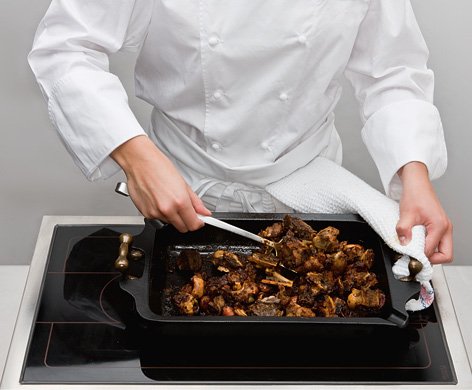
9. Reduce until everything begins to slightly roast again. Repeat once or twice.

10. Once everything has reduced for the third time, place bones in suitable pot.

11. Dissolve juices at the bottom of the pan with water and add to bones.

12. Top up with broth and white wine.

13. Bring to the boil and gently boil for 1.5 to 2 hours. Skim and degrease frequently.

14. Add spices half an hour before the end of the cooking time.
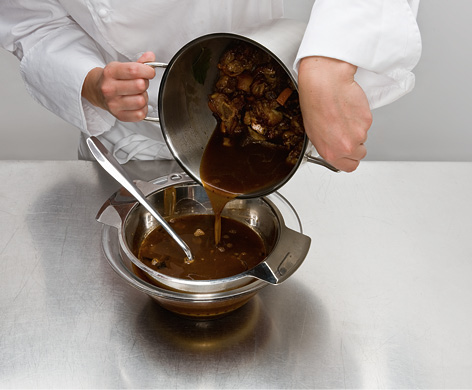
15. Pass through a coarse sieve.

16. Drain off and press bones.

17. Pour through cheesecloth.
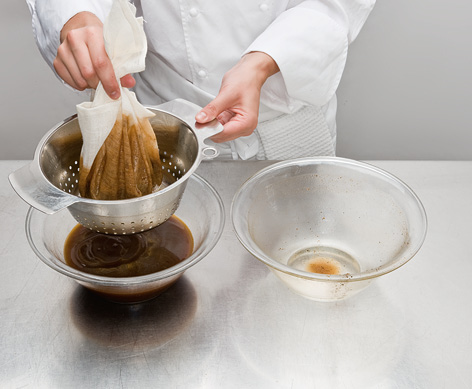
18. Squeeze thoroughly.
Fond de Gibier Brun (Game Stock)
Ingredients for 1 l (1 3/4 pt or 4 1/2 U.S. cups)
20 ml (3/4 fl oz or 1/10 U.S. cups) oil (sunflower or peanut oil)
700 g (1 lb 8 2/3 oz) trimmings and bones of game, chopped into thumb size pieces
100 g (3 1/2 oz) calf’s feet, chopped into thumb size pieces
200 g (7 oz) vegetables: carrots, onions (no leek, would turn bitter during roasting)
30 g (1 oz) tomato puree
1.5 l (2 5/8 pt or 6 1/2 U.S. cups) water (2 to 3 times > 500 ml (18 fl oz 2 1/4 U.S. cups))
600 ml (1 pt or 2 5/8 U.S. cups) white wine
1 l (1 3/4 pt or 4 1/2 U.S. cups) water or Fond Brun
spices: salt, 1 bay leaf, 5 juniper berries, 5 peppercorns, bouquet garni (1 sprig of sage and thyme and parsley stalks)
Preparation
Roasting Variant 1: Mix trimmings / bones of game and calf’s feet with the oil in a frying pan (iron or cast iron pans are best suited, but coated pans also work) and roast slowly and carefully for 1 to 1.5 hours. Turn occasionally. Place bones in a bowl. Slowly and gently roast vegetables for approx. 30 minutes in the same pan. Add tomato puree and roast together for 10 minutes.
Roasting Variant 2: Mix trimmings / bones of game and calf’s feet with the oil, place in (coated or uncoated) metal roasting pan. Place on grid in heated oven (200 °Celsius), medium height. Roast for 1.5 to 2 hours, turn occasionally. Keep an eye on temperature, reduce heat if necessary. Add vegetables, continue to roast for 30 minutes. Add tomato puree, continue to roast for 15 minutes.
According to variant 1, put everything back into frying pan, deglaze with 500 ml (18 fl oz 2 1/4 U.S. cups) of water.
According to variant 2, deglaze with 500 ml (18 fl oz 2 1/4 U.S. cups) of water.
For both variants, boil down water and reduce until everything begins to slightly roast again (reduce to a glaze), then add another 500 ml (18 fl oz 2 1/4 U.S. cups) of water. Repeat once or twice.
Once everything has reduced for the second or third time, transfer to a suitable pot. Rinse cookware or frying pan with a little water and add to bones.
Top up with white wine and 1 l (1 3/4 pt or 4 1/2 U.S. cups) of water. Bring to the boil and frequently skim and degrease. Add spices after one hour.
Gently boil for 1 to 2 hour.
Pass through a coarse sieve, pressing gently. Then strain through a cheesecloth. Season to taste with salt.
Note
Trimmings and bones of furred game: roe deer, deer, wild boar, hare.
Trimmings and bones of game birds: pheasant, partridge etc. Depending on use, only process one variety.
Seasoning with salt: Do not season with salt according to taste and use until the stock has been strained through the cheesecloth.
Slowly roast over low heat, never at excessive heat. Do not burn. Otherwise the stock would develop unpleasant bitter substances and undesirable black pigments. Roasting is a time consuming and continuous process.
You may also replace the entire liquid with red wine, which will give the stock a slightly different flavour and a stronger colour. Disadvantage: There is a risk that the stock will turn greyish when mixed with cream and / or white sauce (e.g. for Sauce à la Crème).
Fond de Veau Blanc (White Veal Stock)
Ingredients for 1 l (1 3/4 pt or 4 1/2 U.S. cups)



